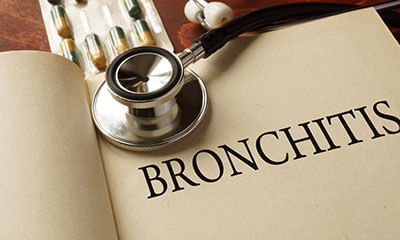Chronic Bronchitis And Its Cure With Homoeopathy
The human respiratory system includes trachea, bronchi, bronchioles, lungs, and diaphragm. Oxygen that we breathe in and carbon dioxide that we breathe out is exchanged in the alveoli (air sacs) inside the lungs.
Bronchitis is a respiratory problem where the lining of the bronchial tubes (it carries air to and from the lungs) becomes inflamed or swells. The reason can be an infection or the person’s lifestyle. People with bronchitis have reduced ability to breathe in air and oxygen into their lungs; they also face discomfort because of the deposition of heavy mucus or phlegm in their airways.

Types of bronchitis
Bronchitis comes in two forms, acute or chronic:
Acute bronchitis
Acute bronchitis occurs mostly during the winter season caused by cold or viral infection, such as the flu. It consists of a cough with mucus, chest discomfort or soreness, fever and sometimes shortness of breath. Acute bronchitis lasts for one to three weeks and usually improves within a few days without lasting effects (although you may continue to cough for a week). If there is a repeated bout of bronchitis, then it requires a medical attention since it is a symptom of chronic bronchitis.
Bronchitis is also caused by bacteria. Bacterial bronchitis occasionally follows a viral upper respiratory infection.
Chronic bronchitis
Chronic bronchitis lasts for at least 3 months a year and two years in a row. It is a serious long-term disorder that requires regular medical treatment. Smoking should be strictly prohibited if a person is down with acute bronchitis since it becomes much harder to recover and difficult to diagnose.
What causes bronchitis?
Acute bronchitis:
The irritated membrane of the bronchial tubes is caused by viruses, typically those that also cause colds and flu or by a bacterial infection.
In some cases, exposure to substances that irritate the lungs, such as tobacco smoke, dust, fumes, vapours and air pollution also stimulates the inflammation.
Chronic bronchitis:
Repeated irritation is the main cause of chronic bronchitis which damages the lungs and airway tissue. Smoking is the most common causes of chronic bronchitis, other causes include continuous exposure to air pollution, dust and fumes from the environment, and repeated episodes of acute bronchitis.
Understanding how smoking is the main cause of chronic bronchitis:
The cigarette smoke damages the tiny hair-like structures in the lungs (cilia) which is responsible for brushing out debris, irritants, and excess mucus from the lungs. This dysfunctional property of the cilia increases the chances of developing chronic bronchitis.
In the case of a chain smoker, the mucous membrane lining the airways stays inflamed and the cilia eventually stop functioning altogether. This results in lungs clogged with mucus which becomes vulnerable to viral and bacterial infections and eventually damages the lung’s airways. This permanent condition is called copd (chronic obstructive pulmonary disease).
Symptoms of bronchitis
Symptoms of bronchitis include:
A cough that is frequent and produces mucusfever (may or may not be present) lack of energywheezing sound when breathing (may or may not be present) sore throatbreathlessnesschest tighteningchillsbody achesheadachesblocked nose and sinuses.
When is medical attention necessary?
Consult with the health care specialist if any of the following problems arise:
A cold that lasts more than two to three weeksa fever greater than 102° fa fever that lasts more than five daysa cough that produces bloodany shortness of breath or wheezinga change in the colour of mucus
Treatments for bronchitis
When someone has bronchitis the best treatment is to take enough rest, stay away from allergens (allergy causing agents), drink lots of fluid and have warm soothing food (like soup and khichdi).
The following are the top homeopathic remedies usrd for cough:
1. Bryonia
Bryonia is often used for a dry, hard, and irritating cough. Patients usually use this if they have an itching pain in the throat or chest that worsens at night. Movement will also make the symptoms worse. Other symptoms with coughs that require bryonia include splitting headaches, and a dry cough accompanied by faintness, vertigo, and nausea.
2. Antimonium tartaricum
Antimonium tartaricum is often used for loose coughs—the patient may even feel like they are suffocating. The patient also alternates between coughing and shortness of breath. Other common symptoms associated with an individual who requires antimonium tartaricum include nausea, vomiting mucus, weakness, drowsiness, hoarseness, and the desire to be left alone.
3. Aconitum napellus
Aconitum napellus is often used for colds and dry, irritating coughs that come on suddenly. Symptoms will get better from warmth, fresh air, and movement; however, symptoms worsen from warm rooms, exposure to pollen or tobacco smoke, in the evening and at night, and during cold, windy, or hot weather.
4. Pulsatilla
Pulsatilla is also an effective remedy for colds and coughs. The patient may cough up thick, yellow-green mucus. The person will experience a loose cough in the morning and a dry cough at night. The person will feel better from open air, but worse in the morning, at night, and in heat.
5. Arsenicum album
Arsenicum album is used for coughs with a burning pain that improves with sips from warm drinks. The person’s symptoms will improve from warm drinks and a warm room, but they worsen from open air and cold.
6. Hepar sulphuris calcareum
Hepar sulphuris is used for a rattling and barking cough that starts after exposure to cold and dry air. Other symptoms include yellowish mucus, constant hoarseness, and wheezing. The person’s symptoms will worsen from lying down, walking, and drafts; however, symptoms get better from rising up and bending the head backwards, a hot compress, and damp air.
7. Causticum
Causticum is another great remedy for dry, deep, and hollow coughs. The person will feel as if they can’t cough deep enough to raise mucus. Other symptoms include hoarseness, burning pains, a sore chest, and tightness. Symptoms get better from damp weather and sips of cold water; however, symptoms worsen from drafts, cold air, stooping, talking, lying, sneezing, and bending the head forward.
8. Rumex crispus
Rumex crispus is often prescribed for a dry cough when a person lies down. The person will feel a tickling sensation in the throat that often leads to a cough. They will also experience long episodes of a dry, hacking, and fatiguing cough. The person will get better from warm air and during the daytime; however, things will worsen from cough after eating, talking, touching the throat, deep breathing, and lying down.
9. Drosera (sundew)
Drosera is a homeopathic remedy used for a dry, deep, barking, hollow, and spasmodic cough that may also produce gagging. The person’s coughing episodes will often last two to three hours. They will also experience vomiting, suffocative attacks, nosebleeds, cold sweats, hoarseness, and holding their sides during coughing bouts. The cough will worsen from lying down, being alone, and while drinking, singing, laughing, and talking.
If the condition is worse or there is no improvement then consult a homeopathic doctor for well selection of the medicine.



+1.svg)
